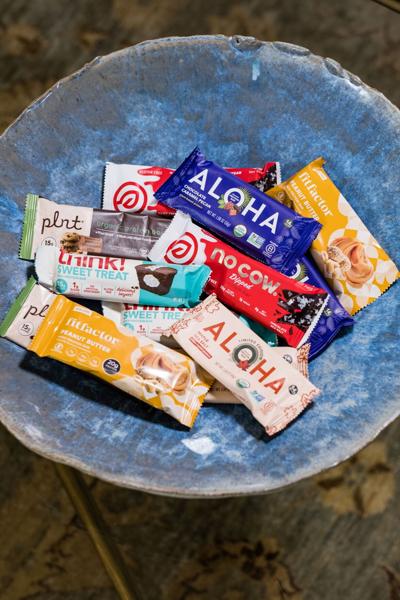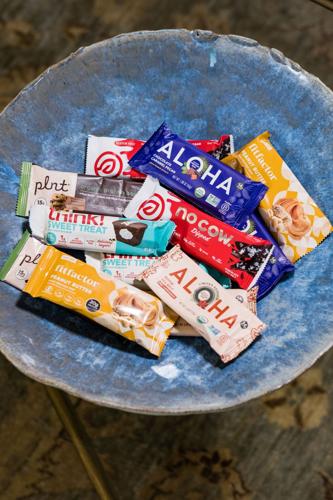Keeping healthy snacks on hand is key for maximizing energy and curbing cravings. And while fresh food snacks are delicious with practically limitless options — Greek yogurt with fresh berries, smoked salmon with whole grain crackers, nut butter on apple slices — they’re not always easy to tote around.
That’s where protein bars come in. These compact, protein-fortified products are convenient and portable, making them an easy option for a snack on-the-go or even a meal in a pinch. There’s been an explosion of new varieties on shelves, but you don’t want to grab just any bar.
Reach for a Clif Energy bar, for example, and you’ll get more than 17 grams of added sugar. That’s the equivalent of four sugar packets! Even a seemingly nutritious, streamlined-ingredient product like a Lara Bar packs in 18 grams of sugar, with a mere four grams of protein.
To find a snack that can keep you feeling satisfied for longer, look for a bar that’s rich in protein (at least 10-15 grams) and lower in sugar (not more than 4 or 5 grams). If it has more sugar than protein, it’s not a protein bar; it’s a candy bar. Try to get close to zero grams of sugar, if possible, and avoid artificial sweeteners and colors.
Net carbs
Most low-sugar bars contain either artificial sweeteners (typically sucralose, aspartame or acesulfame potassium – not recommended) or sugar alcohols (e.g. erythritol).
Sugar alcohols are a specific type of carbohydrate known to have far less of an impact on blood sugar levels. They’re not completely digested, which means they provide fewer calories than other types of carbohydrates – about two calories per gram, versus four calories per gram with regular carbohydrates.
And some sugar alcohols, like erythritol (the sweetener in Truvia and Swerve) have almost no calories – less than 0.02 calories per gram.
If you’re a carb counter, you can determine the ‘net’ carbohydrate impact of a nutrition bar by subtracting sugar alcohols (and fiber) from total carbs.
The American Diabetes Association recommends the following guidelines to account for sugar alcohol when counting carbs:
- If a food has five or more grams of sugar alcohols per serving, subtract half the grams of sugar alcohol from the total carbohydrates.
- Example: If a food has 25 grams of carbs and 18 grams of sugar alcohol, subtract 9 grams from the total, yielding 16 grams of ‘impact’ or ‘net’ carbohydrates. Visit diabetes.org for more details and examples.
- Exception: For products sweetened with erythritol, subtract all of the sugar alcohol from the total carbohydrates to determine net carbs.
Careful, though, consuming too many foods sweetened with sugar alcohols can cause gas and other GI issues.
Ingredient quality
While I’d love to say it’s easy to find a low-sugar protein bar centered on real, whole food ingredients we’d find in our own kitchens, those options are still few and far between. Most of the better bars currently on shelves are a mix of good quality ingredients and some isolated fibers or other types of binding or bulking ingredients, to create a bar that has an appealing taste.
Consider any extras like vitamins, minerals or omega-3s as a bonus, but there’s usually not enough of these add-ins to make a significant nutritional impact.
Over the years, I have tried several DIY recipes for protein bars; none of the very-low-sugar versions have turned out so well. If you have a recipe that’s worked for you, please send it my way!
But how does it taste?
This one is wildly subjective. Personal opinions on the flavor and texture of nutrition bars range from the I-love-it-you-absolutely-must-try-it variety to the it’s-the-worst-thing-I’ve-ever-tasted-i-can’t-believe-anyone-eats-these-things side of the spectrum – and everything in between.
Here are a few of my current favorites, nutritionally speaking. As for how taste and texture measure up – that is 100 percent up to you.
5 protein-rich, low-sugar bars to try
ALOHA | gluten free, dairy free, plant-based
Think! | gluten free, high protein
Bulletproof | gluten free, dairy free collagen protein
Fitfactor | gluten free, high protein
No Cow | gluten free, dairy free, plant-based
Label-reading cheat sheet for protein bars
- Protein: Look for a bar with at least 10 - 15 grams of protein, which is equivalent to about 1.5 - 2 ounces of lean meat.
- Sugar: Look for bars with as close to zero grams added sugar as possible, and with less sugar than protein.
- Artificial sweeteners: Avoid artificial sweeteners like sucralose and acesulfame potassium.
- Fiber: Don’t expect much, as many bars have only “isolated” fibers without the full benefits of real, whole-food fiber.
Molly Kimball, RD, CSSD, is a registered dietitian with Ochsner Health and founder of Ochsner’s Eat Fit nonprofit initiative. For more wellness content, tune in to Molly’s podcast, FUELED Wellness + Nutrition, and follow @MollykimballRD and @EatFitOchsner on social media.


